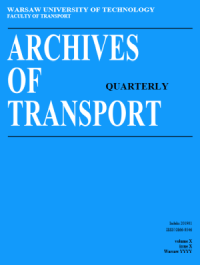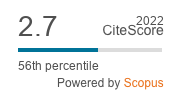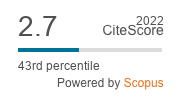Generalized route planning approach for hazardous materials transportation with equity consideration
DOI:
https://doi.org/10.5604/01.3001.0012.2101Keywords:
hazardous materials transportation, transportation, route optimization, risk equity, multi-objective optimization, NSGA-II algorithm, genetic algorithmAbstract
Hazardous materials transportation should consider risk equity and transportation risk and cost. In the hazardous materials transportation process, we consider risk equity as an important condition in optimizing vehicle routing for the long-term transport of hazardous materials between single or multiple origin-destination pairs (O-D) to reduce the distribution difference of hazardous materials transportation risk over populated areas. First, a risk equity evaluation scheme is proposed to reflect the risk difference among the areas. The evaluation scheme uses standard deviation to measure the risk differences among populated areas. Second, a risk distribution equity model is proposed to decrease the risk difference among populated areas by adjusting the path frequency between O-D pairs for hazardous materials transportation. The model is converted into two sub models to facilitate decision-making, and an algorithm is provided for each sub model. Finally, we design a numerical example to verify the accuracy and rationality of the model and algorithm. The numerical example shows that the proposed model is essential and feasible for reducing the complexity and increasing the portability of the transportation process.
References
ABKOWITZ M. D., LEPOFSKY M., CHENG P., 1992. Selecting criteria for designating hazardous materials highway routes. Transportation Research Record, (1333), pp. 30-35.
ALP E., 2016. Risk-Based transportation planning practice: Overall methodology and a case example. INFOR: Information Systems and Operational Research, 33(1), pp. 4-19.
ANDROUTSOPOULOS K. N., ZOGRAFOS K. G., 2010. Solving the bi-criterion routing and scheduling problem for hazardous materials distribution. Transportation Research Part C: Emerging Technologies, 18(5), pp. 713-726.
ASSAEL M. J., PASCHALIDIS L. C., SAKELLAROPOULOS G. P., 2015. Evaluation of the effects of fires and explosions in the transport of hazardous materials. Archives of Transport, 34(2), pp. 7-18.
BELL M. G. H., 2007. Mixed routing strategies for hazardous materials: Decision-making under complete uncertainty. International Journal of Sustainable Transportation, 1(2), pp. 133-142.
BIANCO L., CARAMIA M., GIORDANI S., 2009. A bilevel flow model for hazmat transportation network design. Transportation Re-search Part C: Emerging Technologies, 17(2), pp. 175-196.
BONVICINI S., SPADONI G., 2008. A hazmat multi-commodity routing model satisfying risk criteria: A case study. Journal of Loss Prevention in the Process Industries, 21(4), pp. 345-358.
BRONFMAN A., MARIANOV V., PAREDES-BELMAR G., LÜER-VILLAGRA A., 2015. The maximin HAZMAT routing problem. European Journal of Operational Research, 241(1), pp. 15-27.
CAROTENUTO P., GIORDANI S., RIC-CIARDELLI S., 2007. Finding minimum and equitable risk routes for hazmat shipments. Computers & Operations Research, 34(5), pp. 1304-1327.
CONCA A., RIDELLA C., SAPORI E., 2016. A risk assessment for road transportation of dangerous goods: A routing solution. Transportation Research Procedia, 14, pp.2890-2899.
CURRENT J., RATICK S., 1995. A model to assess risk, equity and efficiency in facility location and transportation of hazardous materials. Location Science, 3(3), pp. 187-201.
DADKAR Y., JONES D., NOZICK L., 2008. Identifying geographically diverse routes for the transportation of hazardous materials. Transportation Research Part E: Logistics and Transportation Review, 44(3), pp. 333-349.
ERKUT E., INGOLFSSON A., 2000. Catastrophe avoidance models for hazardous materials route planning. Transportation Science, 34(3), pp. 165-179.
ERKUT E., VERTER V., 1995. A framework for hazardous materials transport risk assessment. Risk Analysis, 15(5), pp. 589-601.
GIANNIKOS I., 1998. A multiobjective programming model for locating treatment sites and routing hazardous wastes. European Journal of Operational Research, 104(2), pp. 333-342.
JIN H., BATTA R., 1997. Objectives derived form viewing hazmat shipments as a sequence of independent Bernoulli trials. Transportation Science, 31(3), pp. 252-261.
KANG Y., BATTA R., KWON C., 2014. Generalized route planning model for hazardous material transportation with VaR and equity considerations. Computers & Operations Re-search, 43237-247.
KEENEY R. L., 1980. Equity and public risk. Operations Research, 28(3-part-i), pp. 527-534.
LINDNER-DUTTON L., BATTA R., KARWAN M. H., 1991. Equitable sequencing of a given set of hazardous materials shipments. Transportation Science, 25(2), pp. 124-137.
LIST G., MIRCHANDANI P., 1991. An integrated network/planar multiobjective model for routing and siting for hazardous materials and wastes. Transportation Science, 25(2), pp. 146-156.
LOZANO J. A., GÁMEZ J. A., MORENO J. A., MACHUCA E., MANDOW L., de la CRUZ J. L. P., IOVANELLA A., 2011. "Heuristic multiobjective search for hazmat transportation problems", in Springer Berlin Heidelberg, pp. 243-252.
MACHUCA SÁNCHEZ E., 2012. An analysis of some algorithms and heuristics for multi-objective graph search., Universidad de Málaga.
MANDOW L., De La CRUZ J. L. P., 2010. Multiobjective a* search with consistent heuristics. Journal of the ACM, 57(5), pp. 1-25.
PRADHANANGA R., TANIGUCHI E., YAMADA T., QURESHI A. G., 2014. Bi-ob-jective decision support system for routing and scheduling of hazardous materials. Socio-Economic Planning Sciences, 48(2), pp. 135-148.
REVELLE C., COHON J., SHOBRYS D., 1991. Simultaneous siting and routing in the disposal of hazardous wastes. Transportation Science, 25(2), pp. 138-145.
ROMERO N., NOZICK L. K., XU N., 2016. Hazmat facility location and routing analysis with explicit consideration of equity using the Gini coefficient. Transportation Research Part E: Logistics and Transportation Review, 89165-181.
SIVAKUMAR R. A., BATTA R., KARWAN M. H., 1995. A multiple route conditional risk model for transporting hazardous materials. IN-FOR: Information Systems and Operational Research, 33(1), pp. 20.
TOUMAZIS I., KWON C., 2015. Worst-Case conditional Value-at-Risk minimization for hazardous materials transportation. Transportation Science, 50(4), pp. 1174-1187.
XIE C., WALLER S. T., 2012. Optimal routing with multiple objectives: Efficient algorithm and application to the hazardous materials transportation problem. Computer-Aided Civil and Infrastructure Engineering, 27(2), pp. 77-94.
ZOGRAFOS K. G., ANDROUTSOPOULOS K. N., 2008. A decision support system for integrated hazardous materials routing and emergency response decisions. Transportation Research Part C: Emerging Technologies, 16(6), pp. 684-703.
Downloads
Published
Issue
Section
License
Copyright (c) 2024 Archives of Transport journal allows the author(s) to hold the copyright without restrictions.

This work is licensed under a Creative Commons Attribution 4.0 International License.











